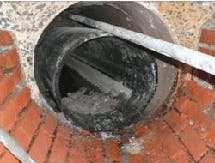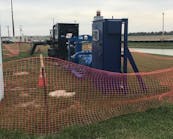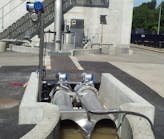John E. Davis, Internal Sales / Marketing Specialist
undefined
The wastewater collecting system on the island of St. Croix in the United States Virgin Islands was facing significant corrosion. Sauereisen materials were used to upgrade the wastewater infrastructure in St. Croix, a restoration project that also included specifications for sealing annular spaces. The goal of the project was to provide an economic and expedient system that would inhibit water inflow and infiltration, while protecting the structures from microbiologically induced corrosion (MIC).
Contributing to the problem
A strain of bacteria commonly found in the wastewater environment ingests hydrogen sulfide and secretes sulfuric acid in its respiration process. The acid created attacks concrete exposed structures. In a region like St. Croix where the climate is typically warm and humid, the bacteria will thrive, accelerating the MIC process.
The Environmental Group of San Juan, Puerto Rico, was chosen to complete the engineering for this project. PipeLiners Company from San Juan, Puerto Rico, served as the contractor, due to their strong reputation in the Caribbean.
Wastewater projects and rehabilitation are becoming more prevalent in Latin America, Puerto Rico and the Caribbean, due to increased awareness of clean water. The owners, engineers, and contractor all determined the method of rehabilitation together, as well as the selection of an appropriate chemical-resistant lining to preventing future corrosion.
The emergency restoration project included an impermeable polymer lining provided by Sauereisen, Inc. of Pittsburgh. The lining, SewerGard No. 210RS , has a track record of rehabilitation and for withstanding corrosive conditions. Sauereisen’s SewerGard family of products had proven successful for decades throughout the U.S., Puerto Rico, Mexico, and South America.
The Bethlehem Interceptor was located next to the waste treatment facility in St. Croix, and extensive excavating was necessary to reach the bottom inflow area of the manhole. After exposing the deteriorated interceptor pipe, the entire structure was hydrojetted at 7,000 pounds pressure to thoroughly clean the manhole and exposed pipe from all chemical contaminants and laitance. A new steel pipe 10 feet in length and 24 inches in diameter was inserted into the manhole from the outside to replace the severely deteriorated brick and mortar channel that was suffering from extensive corrosion and inflow/infiltration problems. The existing opening was 30 inches wide, causing a six-inch void between the old pipe and the one newly inserted.
Additional problems, more solutions
The installers encountered several other unique obstacles during the installation process. Due to the warm, humid climate in the region, equipment used to pump the substrate materials into the annular cavities were over-heating. Ice was packed around the pump motors to keep them running efficiently.
The open space around the new piping was filled using Sauereisen Substrate Resurfacer No. F-121 , RFI Pumping Equipment and the newly fabricated piping assembly. A special delivery tube needed to be fabricated to transport the substrate repair material from the pump hoses into the annulus surrounding the newly installed pipe. The tube needed to reach all unfilled areas and have the capacity to deliver the materials at a rate that would fill all voids uniformly.
The manhole portion of the project was divided into three phases:
Phase I: It was first necessary to rehabilitate the existing manhole structure. After hydrojetting the surface, areas of severe deterioration were restored with Sauereisen Substrate Resurfacer No. F-121 . Isolated voids less than 1/8 inch were filled with Sauereisen Filler Compound No. 209 . The few active leaks that were visible were sealed using Sauereisen InstaPlug No. F-180 , a quick-setting hydraulic patching compound.
Phase II: Upon completion of the surface preparation, the entire manhole was coated at a consistent thickness of 1/8 inch with Sauereisen’s No. F-121 from street level. A uniform coat was obtained using an RFI rotor-stator pump and spinning nozzle. A firm, smooth surface was now in enabling the appropriate topcoat to be applied.
Phase III: At this point a chemical-resistant barrier was applied using the same equipment as Phase II. SewerGard No. 210RS Lining System was specified to deliver that protection. No. 210 RS is packaged in pre-measured containers consisting of resin, hardener, and powder. The No. 210RS was blended using a drill motor and jiffy blade and then applied at a thickness of 125 mils using a pump and a straight shot nozzle.
The Sauereisen method of restoration and protection enabled the contractor to complete the job in a reasonable amount of time with minimal affect on the area. The Sauereisen materials restored the underground structure and also provided long-term corrosion protection.


